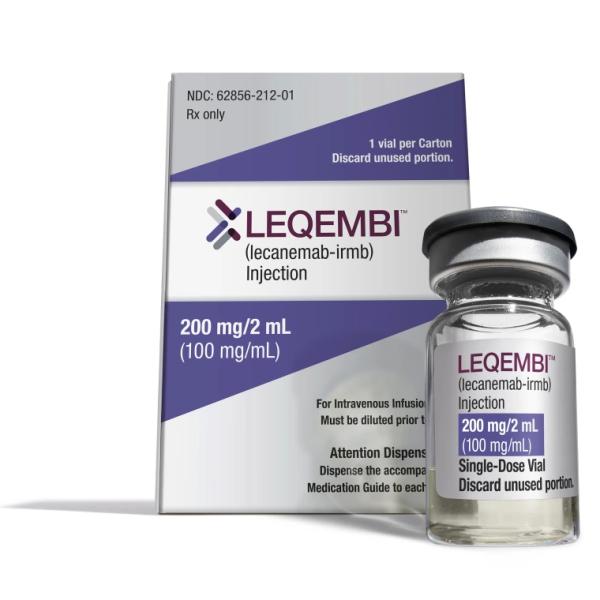Lecanemab Dosage
Medically reviewed by Drugs.com. Last updated on Jun 30, 2025.
Applies to the following strengths: irmb 100 mg/mL
Usual Adult Dose for:
Additional dosage information:
Usual Adult Dose for Alzheimer's Disease
IV infusion of 10 mg/kg over approximately 1 hour, once every two weeks
Comments:
- This drug is approved under accelerated approval based on reductions in amyloid beta plaques observed in patients treated.
- Continued approval for this indication may be contingent upon verification of clinical benefit in a confirmatory trial.
- Presence of amyloid beta pathology should be confirmed before starting this treatment.
Use: Alzheimer's disease
Renal Dose Adjustments
Data not available
Liver Dose Adjustments
Data not available
Dose Adjustments
Dosing recommendations for patients with ARIA-E:
- Clinically asymptomatic
- Mild (Severity on MRI): Dosing may be continued
- Moderate or Severe (Severity on MRI): Dosing should be suspended
- Clinically mild symptoms
- Mild (Severity on MRI): Dosing can be continued based on clinical judgment
- Moderate or Severe (Severity on MRI): Dosing should be suspended
- Clinically moderate or severe: Dosing should be suspended
Dosing recommendations for patients with ARIA-H:
- Clinically asymptomatic
- Mild (Severity on MRI): Dosing may be continued
- Moderate or Severe (Severity on MRI): Dosing should be suspended
- Clinically symptomatic: Dosing should be suspended
Precautions
CONTRAINDICATIONS: None
Safety and efficacy have not been established in patients younger than 18 years.
Consult WARNINGS section for additional precautions.
Dialysis
Data not available
Other Comments
Administration advice:
- The solution should be visually inspected for the presence of any particulate matter or discolorations before administration.
- Allow the drug to come to room temperature before infusion.
- The entire volume of solution should be infused over one hour via an intravenous line equipped with a terminal low-protein binding 0.2 micron in-line filter.
- Flush intravenous line to ensure complete drug delivery.
- Patient should be monitored for any signs and symptoms of an infusion-related reaction.
- The infusion rate can be reduced, or infusion can be discontinued based on severity of infusion related reactions and patients should be treated appropriately as clinically indicated. Pre-medications can be administered as needed.
Storage requirements:
Unopened vial:
- Store at 2C to 8C (36F to 46F).
- Store in the original carton to protect from light.
- Do not freeze or shake.
- Solution should be used immediately after dilution. If not, then, prepared solution can be stored refrigerated at 2C to 8C (36F to 46F) or at room temperature up to 30C (86F) for up to 4 hours.
- Do not freeze.
Reconstitution/preparation techniques:
- The drug product must be diluted in 250 mL of 0.9% sodium chloride injection, USP.
- Refer to manufacturer product information for calculation of dose based on patient's body weight.
Monitoring:
- Monitor for amyloid related imaging abnormalities including edema (ARIA-E) and hemosiderin deposition (ARIA-H).
- Brain magnetic resonance imaging (MRI) should be obtained (within 1 year) before starting this treatment and during treatment before 5th, 7th, and 14th infusions.
Patient advice:
- Patients should be advised to read FDA approved patient labeling.
- Patients should be informed about the adverse reactions this drug may cause, such amyloid related imaging abnormalities (ARIA) and infusion-related reactions.
- Patients should be informed about the symptoms of ARIA such as headache, confusion, dizziness, vision changes, nausea, aphasia, weakness, or seizure and should reach out to their healthcare provider if they develop any of these.
- Patients should be informed that concomitant use of antithrombotic or thrombolytic medications can increase the risk of bleeding in the brain.
- Patients should be made aware that periodic MRI monitoring is required.
- Patients who are ApoE E4 homozygotes are more likely to develop ARIA, and a test for the presence of ApoE E4 genotype is available.
- Patients should be informed about the risk of infusion related reactions which can present as flu-like symptoms, nausea, vomiting, and changes in blood pressure, most of which occur with the first infusion.
- Patients should be encouraged to participate in the Alzheimer's Network for Treatment and Diagnostics (ALZ-NET) which is a voluntary provider-enrolled patient registry that collects information on treatments for Alzheimer's disease.
Frequently asked questions
- What drugs can help improve or slow down memory loss?
- What's the mechanism of action for Leqembi (lecanemab-irmb)?
More about lecanemab
- Check interactions
- Compare alternatives
- Reviews (3)
- Side effects
- During pregnancy
- Drug class: miscellaneous central nervous system agents
- En español
Patient resources
Other brands
Professional resources
Other brands
Related treatment guides
See also:
Further information
Always consult your healthcare provider to ensure the information displayed on this page applies to your personal circumstances.


